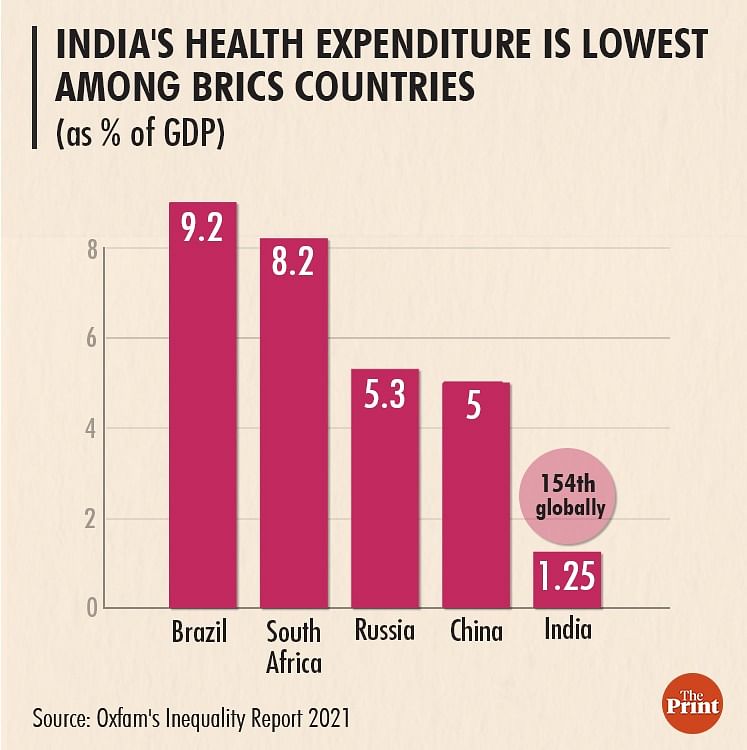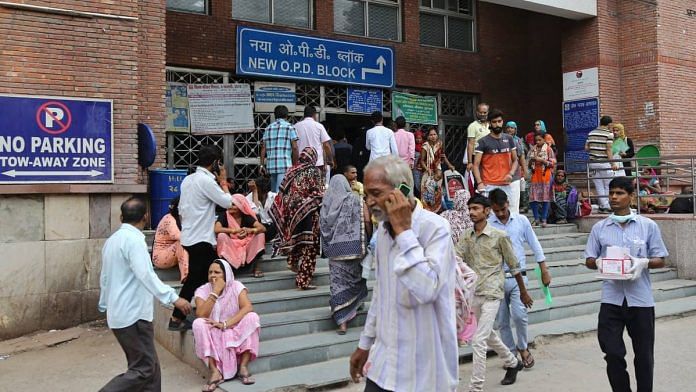New Delhi: Stark inequalities in access to healthcare exist in India across class and caste, a new Oxfam report on the country’s health system found.
Oxfam’s Inequality Report 2021: India’s Unequal Healthcare Story showed how the class and caste inequalities lead to difference in age expectancy, infant mortality and sanitation, among others.
The report, which used data from rounds 3 and 4 of the National Family Health Survey and various rounds of National Sample Survey, described the findings as an indicator of the “social gradient in health”.
According to the report, the rich outlive the poor by seven and a half years, and an upper caste woman lives 15 years more than a Dalit woman.
“Using temporal data for the period 2011-15, an analysis of Inequality in life expectancy at birth in India reveals that life expectancy based on wealth is 65.1 years for the bottom 20 percent of the households, while it is 72.7 years for the top 20 percent, with a difference of 7.6 years. The rich, on an average, live seven and a half years more than the poor,” the report said Tuesday.
It underscored how this gap was evident during the Covid-19 pandemic, when the poor couldn’t access healthcare services.
“The closure of government health facilities for non-Covid services and loss of livelihoods and incomes combined obstructed the poor from seeking medical care. This inability of the public healthcare services to accommodate the underserved population comprising the poor, marginalised and women portrays the inefficiencies of the public healthcare system in India to make healthcare accessible and affordable to all,” it said.
The report used five major indicators to highlight inequalities in the healthcare system: gender, geography, wealth groups, social groups and religion.
Also read: Assam doctor infected with Alpha & Delta variants of Covid simultaneously, first in India
Low health expenditure
According to the report, India was the worst performing BRICS nation on health expenditure.
“The current expenditure on health, by the centre and the state governments combined, is only about 1.25 percent of GDP which is the lowest among the BRICS countries—Brazil (9.2%) has the highest allocation, followed by South Africa (8.2%), Russia (5.3%) and China (5%),” the report said.

Moreover, India’s health expenditure was noted to be among the worst in the world, ranked 154th globally.
However, the report said access to healthcare in India has improved over the decades, with its global rank rising to 145 in 2016 from 153 in 1990, but still remains lower than Bangladesh (132), Sri Lanka (71), Bhutan (134) and BRICS counterparts like Brazil (96), Russia (58), China, and South Africa (127).
Also read: No deaths due to oxygen shortage reported by states, UTs in second wave, says Centre
Low expenditure affects the poor
The low expenditure on health in the country affects the poor disproportionately, the report said, adding that the poor have been left with two broad choices — using sub-optimal/weak public healthcare, or expensive private healthcare.
Out-of-pocket health expenditure in India is 64.2 per cent, higher than the global average of 18.2 per cent, it observed, adding that exorbitant healthcare expenditure has forced many to sell assets or incur debt.
It highlighted the government estimates that 63 million people are pushed to poverty in India every year due to healthcare costs alone. “74 per cent of hospitalization cases are financed through savings while 20 percent of the cases are financed through borrowing. In rural areas, however, the main source of healthcare financing continues to be selling of household assets and mortgaging ornaments to borrow at high interest rates, followed by income/ savings,” it said.
“The weak public healthcare system that has failed to address socioeconomic determinants of health has led to inequalities in health,” the report said.
Differences along class lines
The infant mortality rate (IMR) in the country is skewed in favour of the rich. IMR among the rich is 19.8 per cent while for poor it is 56.3 per cent even as the country’s average is 40.7 per cent.
Access to clean drinking water is also a privilege enjoyed by the rich. “While 93.4 per cent of households in the top 20 per cent have access to improved sanitation, only 6 per cent have access in the bottom 20 per cent — a difference of 87.4 per cent,” the report said.
Positive indicators
The Oxfam report also noted improvements on some health indicators. For example, share of institutional deliveries in India increased from 38.7 per cent in 2005-06 to 78.9 per cent in 2015-16. Births under supervision mean lesser risk of maternal or neonatal deaths.
The number of fully immunised children aged 12-23 rose from 43.5 per cent in 2005-06 to 62 per cent in 2015-16. “In almost three-fourths of districts, 70 percent or more children aged 12-23 months are fully immunized against diseases. This can be attributed to the flagship initiative of Mission Indradhanush launched by the government since 2015,” the report said.
However, Covid threatens the progress of immunisation in India, and such a disruption might leave behind the largest group of unimmunised children in the world.
The percentage of women in the 15-19 age group reportedly being mothers or pregnant dropped significantly from 16 per cent in 2005-06 to 8 per cent in 2015-16.
Also read: In 10 days, Health Minister Mansukh Mandaviya shows how he’s different from Harsh Vardhan



